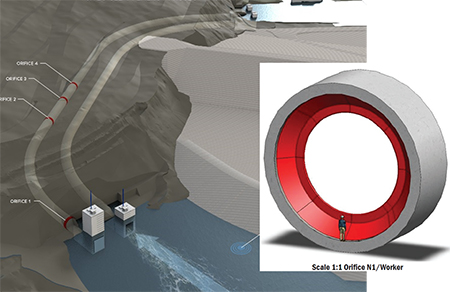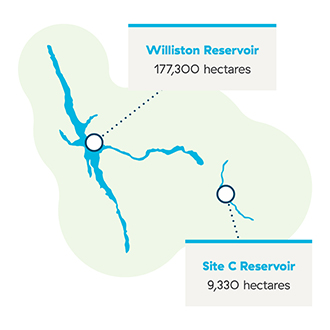Filling the reservoir
One of the last steps in building the Site C dam is to fill the reservoir. Reservoir filling will take about four months, widening the Peace River by an average of two to three times.
Filling the reservoir nav
Filling the Reservoir
One of the last steps in building Site C is to fill the reservoir, which allows us to put the generating station, spillways, turbines and generators into operation. This will provide 1,100 megawatts of capacity, and produce about 5,100 gigawatt hours of electricity each year – enough to power 450,000 homes or 1.7 million electric vehicles.
When Site C is fully operational, it will generate about 35% of the energy of the W.A.C. Bennett Dam, with just 5% of the reservoir area.
Tunnel conversion is complete

Prior to filling the reservoir, we install four large rings in one of the diversion tunnels to restrict the flow of water.
Tunnel conversion, a key step in preparing for reservoir filling, is now complete.
Since 2020, two tunnels have been diverting the Peace River around the dam site to allow us to build the earthfill dam.
We started the process of tunnel conversion in June 2023. Over the course of 12 weeks, we installed four large rings inside one of the tunnels to restrict the flow of water once reservoir filling begins.
Tunnel conversion needed to take place between July and September due to environmental, operational, and weather-related constraints as well as construction progress.
Converting the tunnels helps control the flow of water
Once we decide to fill the reservoir, water will be restricted in the tunnels, causing the water level to rise. When the water is high enough to flow through the spillway, both tunnels will close.
Flows downstream will continue throughout reservoir filling. The diversion tunnels will be permanently sealed and filled in after reservoir filling is done.

Reservoir filling takes up to four months
- The reservoir will widen the Peace River by two to three times, on average.
- The water level will rise between 30 centimetres and 2.5 metres a day.
- The reservoir will be 52 metres deep close to the dam, 36 metres deep at Halfway River, and 18 metres deep near Hudson's Hope.
- The reservoir will cover 5,550 hectares of land, with a total surface area of about 9,330 hectares. It will be 83 kilometres long.
Watch this video to learn how we fill the reservoir:
Before filling the reservoir, the following must be complete:
- Reservoir clearing and final sweeps
- Highway 29 realignment activities
- Earthfill dam built and fit for service
- Obtain regulatory authorization and community consultation
- Convert the diversion tunnels
- Approach channel, spillways, and tailrace at the dam site
While filling the reservoir is one of the last activities require to complete the dam, clearing the area began years in advance. We have removed trees and vegetation from the dam site and the reservoir area to ensure boater safety and reduce impacts to dam construction and operations.
Reservoir clearing and debris management activities continue through 2023. This includes road construction, logging, hauling timber to local mills and waste wood burning.
We recognize the importance of this final step, and the impacts on local communities and Indigenous peoples. We’ll continue to communicate expected changes and timing of reservoir filling before it begins with Indigenous Nations and all stakeholders in the Peace Region, including local government and residents.
Prior to filling the reservoir, more than 20 regulatory approvals must be met. In addition to these authorizations, reservoir filling must consider BC Hydro’s operation of the Peace River system, both up and downstream impacts, environmental and weather constraints, as well as the construction progress.
Learn More